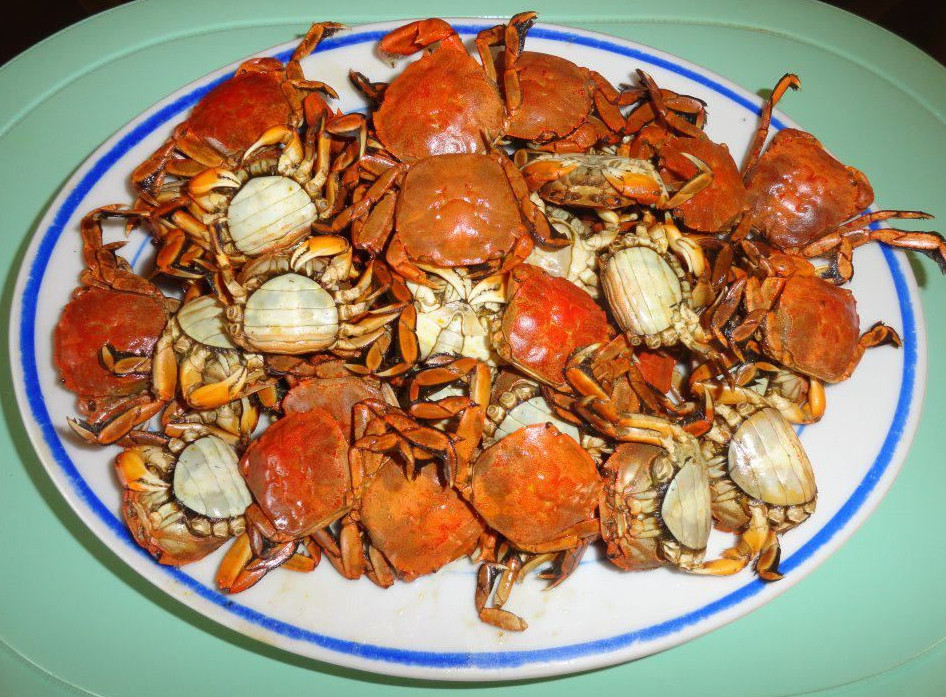(Are you here because you are researching Talangka crab? You are in the right place, so continue reading.
Talangka crab (Tagalog), also known as the herring bow crab or paddler crab, is a small crab species in the Indo-West Pacific region. It is commonly found in mangroves, estuaries, freshwater environments, and shallow subtidal areas. Talangka is a euryhaline crab that can tolerate a wide range of salinity levels. It is typically found in slow-moving or almost stagnant waters, and it can also be found in the sea. The species is also called Kalampay in Hiligaynon-speaking provinces, especially in Negros Occidental.

In some parts of Metro Manila and other Tagalog-speaking regions, the crab is also called “aligi” because of its eggs, which are a pricey delicacy.
Adult Talangka crabs typically measure about 2-3 cm in length. It has a flattened body with a brown or green carapace. The legs are paddle-shaped, which helps the crab to swim. Talangka is a scavenger that feeds on various organic matter, including algae, detritus, and small invertebrates.
Talangka is an important food source for many people in the Indo-West Pacific region. It is also used in traditional medicine. In some areas, talangka is also used as a bait for fishing.
Here are some additional details about talangka:
- The scientific name of talangka is Varuna litterata.
- It is a member of the family Varunidae, which also includes the mud crab and the mangrove crab.
- Talangka is a prolific breeder that can produce up to 100,000 eggs annually.
- The eggs are laid in a sticky mass that attaches to underwater vegetation.
- The larvae hatch after about two weeks and go through a series of molts before reaching adulthood.
- Talangka can live for up to two years.
Talangka is an essential part of the coastal ecosystem and is a valuable food source for many people. It is also a potential source of new medicines. With its wide distribution and adaptability, talangka is likely to remain an important resource for many years to come.
Alimasag vs Talangka, What’s the Difference?
Talangka are relatively smaller than Alimasag (blue crab) and their habitat is also different. Kalampay crabs (talangka) can be found in mangroves and seaside, while blue crabs (Alimasag) are found offshore deeper waters.
Talangka Crab Health Benefits
The talangka crab is primarily known for its culinary uses and cultural significance rather than being recognized for specific health benefits. In various Southeast Asian cuisines, talangka crabs are considered a delicacy and are used to enhance the flavors of dishes due to their unique taste. However, it’s important to note that limited scientific research is available on the potential health benefits of consuming talangka crabs.
Like other seafood, crabs in general are a good source of protein, essential minerals, and some vitamins. They also contain healthy omega-3 fatty acids associated with heart health and brain function. However, the specific nutritional profile of talangka crabs and any unique health benefits they may offer haven’t been extensively studied or documented.
If you are considering incorporating talangka crabs or any other seafood into your diet, it’s advisable to consume them in moderation as part of a balanced diet. Additionally, individuals with allergies to shellfish should exercise caution and consult a medical professional before consuming any crab.
As always, it’s essential to rely on well-established sources of nutritional information and consult with healthcare professionals or registered dietitians for personalized dietary recommendations based on your health needs and goals.
Popular Talangka Recipe (How to Cook Talangka)
Here is a recipe for talangka crab:
Ingredients:
- 1 kg talangka, cleaned and deveined
- 1/2 cup vegetable oil
- 1 onion, chopped
- 5 cloves garlic, minced
- 1 inch ginger, minced
- 1/2 teaspoon black peppercorns
- 1/2 teaspoon ground turmeric
- 1/2 teaspoon salt
- 1 cup coconut milk
- 1/2 cup water
Instructions:
- Heat the oil in a large pan over medium heat. Add the onion and cook until softened, about 5 minutes.
- Add the garlic, ginger, peppercorns, and turmeric, and cook for another minute.
- Add the talangka and cook until they turn orange, about 5 minutes.
- Add the coconut milk and water and bring to a boil. Reduce heat to low and simmer for 10 minutes or until the talangka are cooked through.
- Season with salt to taste. Serve hot with rice.
Here are some tips for cooking talangka crab:
- Make sure to clean the talangka thoroughly before cooking. This will remove any dirt or sand that may be present.
- If you use live talangka, boil them for a few minutes before cooking them in the pan. This will help to remove some of the impurities.
- Add other vegetables to the pan, such as carrots, potatoes, or green beans.
- You can add chili peppers to the pan if you want a spicier dish.
See Also:
- Paros Shell: 5 Health Benefits of Soletellina diphos and Side Effects
- Moong Fish Description and Characteristics
- Tabilos Fish: Pope’s Ponyfish Description and Characteristics
- Dapa Fish: 10 Health Benefits of Flatfish, Description, and Side Effects
- Banak: 10 Health Benefits of Mullet Fish Description and Side Effects
